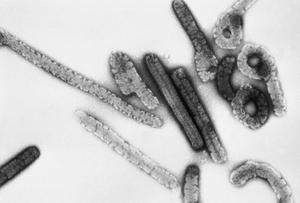Public healthPreventing animal-borne diseases from affecting humans
Roughly 75 percent of newly emerging diseases are zoonotic, which means that they can spread from animals to humans. Incredibly damaging, these diseases usually wreak havoc on humans, who rarely have natural defenses to protect them against such strains. About 2.7 million people die each year from zoonotic diseases. It is estimated that between 1997 and 2009, the cost of dealing with and treating these types of diseases around the world amounted roughly $80 billion. Scientists hope that by connecting human medical and veterinary science, and by organizing and establishing different medical professionals along a spectrum of disease detection, it would be possible to thwart the outbreak of another zoonotic disease.

Electron micrograph of Marburg virus, a zoonotic virus // Source: commons.wikimedia.org
Researchers are trying better to understand how animal-borne illnesses can jump to humans, hoping to prevent animal-to-human trnasmission as much as possible through better medical and veterinary practices.
As the Atlantic reports, roughly 75 percent of newly emerging diseases are zoonotic, which means that they can spread from animals to humans. Incredibly damaging, these diseases usually wreak havoc on humans, who rarely have natural defenses to protect them against such strains. About 2.7 million people die each year from zoonotic diseases. It is estimated that between 1997 and 2009, the cost of dealing with and treating these types of diseases around the world amounted roughly $80 billion.
These diseases — which include Ebola, Rabies, and MERS — catch many off guard.
“Once outbreaks originate, like we are seeing with Ebola, often it is too late. [But] often, infectious disease circulate in animals for a long time before they cause outbreaks in humans,” said Wondwossen Gebreyes, the director of Global-Health Programs at Ohio State University.
Because of that, researchers are taking a new approach toward finding and isolating zoonotic diseases before they come into contact with humans. Working with veterinarians, they are now attempting to look for the disease in the wild, or as they affect animals.
“There is very little research going on in animal diseases,” said Laura Kahn, a Princeton professor. She cites a case in 1999 in which Tracey McNamara identified the first outbreak of the West Nile virus in North America by studying the die-offs of certain bird populations. “The veterinarian cracked the case, and no one was interested in talking with her because she was a veterinarian.”
This broader concept — connecting human medical and veterinary science — is called “One Health.” By organizing and establishing different medical professionals along a spectrum of disease detection, scientists hope to thwart the outbreak of another zoonotic disease.
